Author | Zheng Wen
Editor | Zhou Changxian
Let’s start with a picture. Recently, a chart showing the percentage of NIO charging station services went viral on social media.
The data in the picture shows that during the Chinese New Year period, 76% of the electricity from NIO charging stations was used by non-NIO brands. Generally speaking, charging facilities of electric vehicle brands are not open to the public. Such alternative data quickly attracted widespread attention and discussion from the industry.
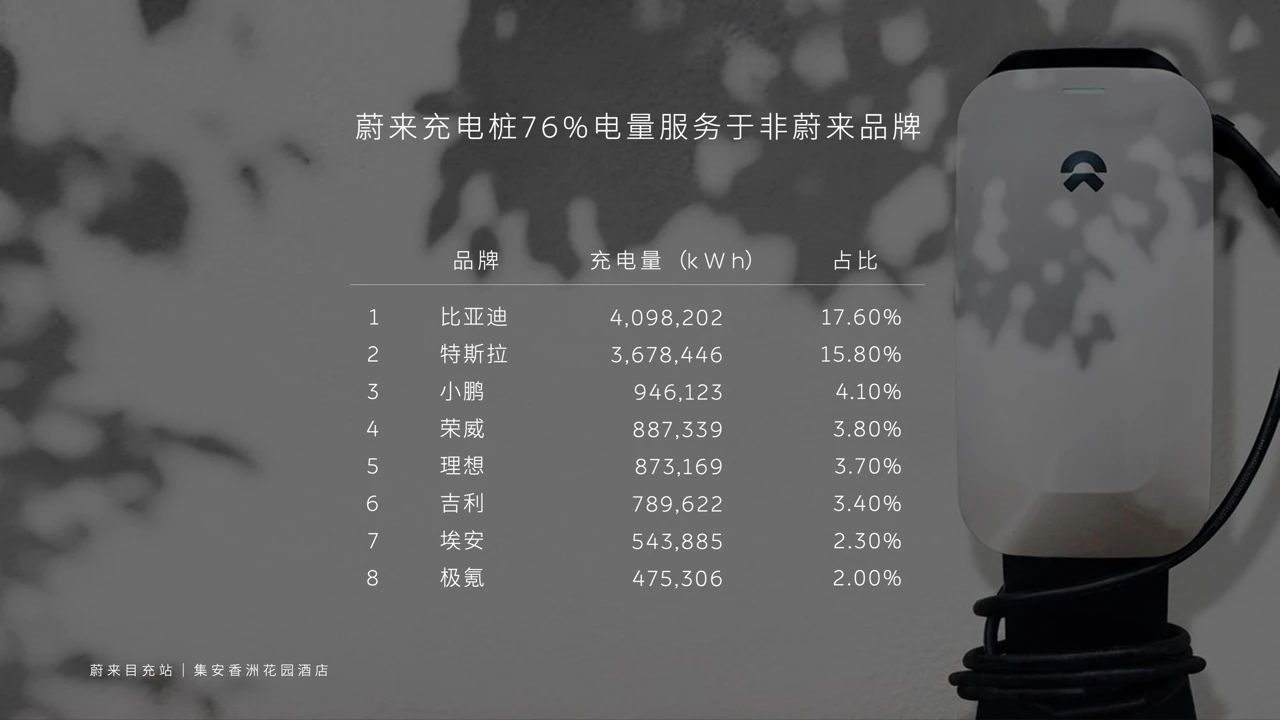
In fact, it is well known in the industry that NIO has already tilted a large amount of resources to improve its energy supplement services. Anyone who follows NIO’s co-founder and CEO, Qin Lihong’s WeChat Moments, knows that he regularly updates information on newly added battery swap stations and charging stations.
Unknowingly, NIO has become the brand with the largest number of charging stations in the Chinese market. As of February 14, 2023, NIO has 2,331 charging stations and 13,697 charging piles. In addition, NIO has the most battery swap stations, with 1,313 stations, of which more than 1/4 are located on highways.
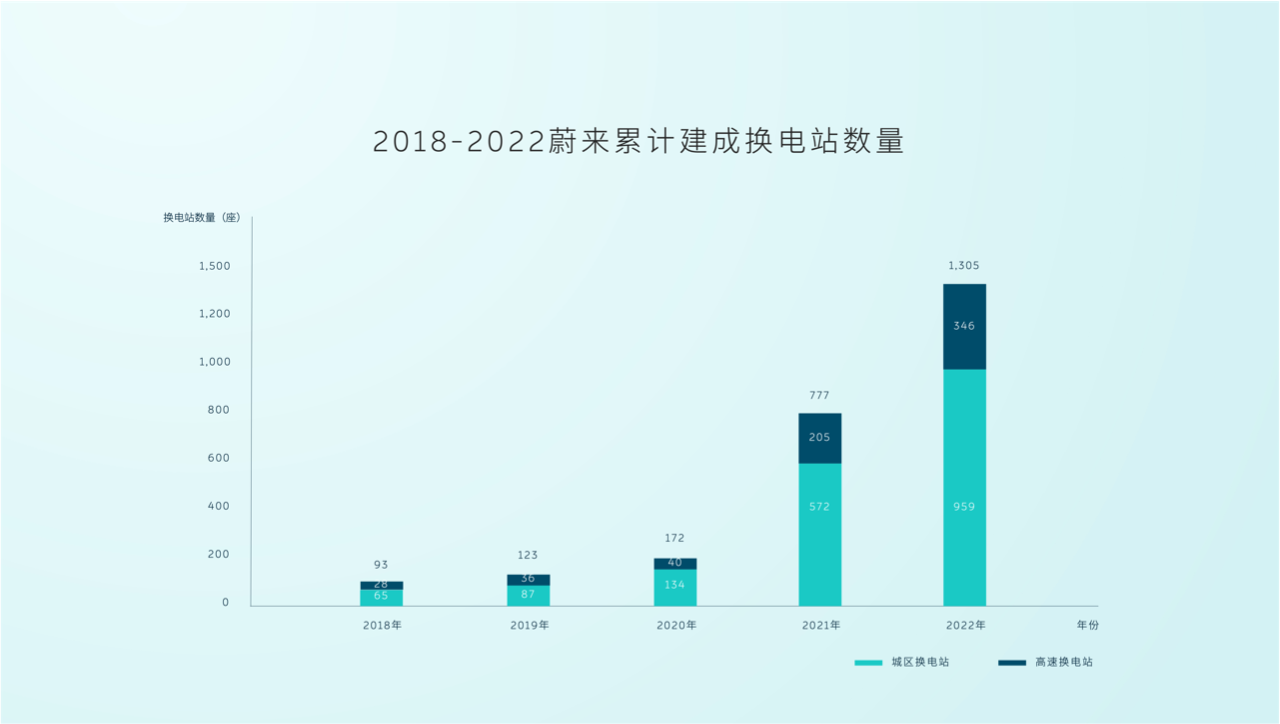
“Chunyun” is a unique phenomenon in China, known as the largest and most periodic migration in human history, with obvious tidal phenomena. Such a high demand for energy supplement services in a short period of time is a huge challenge for any brand service provider. From the results, this stress test is no less than a major exercise, and NIO has withstood the challenge.
The data shows that during this year’s Spring Festival period (January 13 to February 5, 2023), NIO provided free battery swap services to NIO car owners 372,324 times at 348 highway battery swap stations nationwide. At the same time, NIO’s charging services provided more than 900,000 charging sessions for NIO car owners during the Spring Festival travel rush.
Behind this is not only the rapid growth of NIO’s energy supplement system, but also the fact that it has become an insurmountable moat for NIO.## Stand Out with Differentiated Layout amidst Controversy
In NIO’s values, full-lifecycle service includes both vehicle service and energy service. That’s why NIO has been exploring how to improve energy services.
However, it has been a difficult process due to various factors. For example, in Shanghai, one of the most developed cities in China, only 40% of residents can install charging piles at home due to factors such as property management and old residential communities.
Moreover, NIO did not anticipate that battery swap stations would be distributed during its early stage. The team originally envisioned a large station that ran like a power plant, with thousands of batteries circulated overnight for 48 hours and then charged. It is only later that the team gradually realized that this idea was not feasible.
“We once thought of mobile battery swap services, like the cars in Toy Story,” said Qin Lihong. In terms of battery swap services, today’s products and layouts are mainly explored step by step by Dr. Shen Fei, NIO’s Senior Vice President of Energy Solutions, and his team.
Indeed, NIO’s achievements today are not obtained by luck, but by many “stupid” practical methods. With energy replenishment convenience as the result orientation, NIO’s “rechargeable, swappable, and upgradable” energy service system has a wide coverage, including four convenient charging scenarios: battery swap, home charging piles, en route charging, and “one-click charging”.
These explorations are actually similar to the development of gas stations. There were no gas stations in the beginning, and gasoline was stored in containers and sold by retailers. However, fuel efficiency was very low during this period. During the development of gas stations, retailers also envisioned a “door-to-door refueling” service, which was an emergency service similar to NIO’s mobile charging car. At that time, each car owner needed to equip a large fuel tank in the garage for refueling, much like today’s private charging piles.
Interestingly, just like the popularity of self-service gas stations, NIO’s battery swap stations are also trying unmanned attempts. “If I remember correctly, about 150 battery swap stations in China have already begun unmanned attempts. Unmanned operation is particularly important, not only in terms of technology, but also in terms of the long-term financial costs and sustainability of the entire battery swap network,” said Qin Lihong.“Only 30% of people recognize NIO’s battery swap service today. 70% of people may still see it as our fatal weakness. But I think this is our opportunity,” Qin Lihong admitted, “If everyone reaches a quick consensus on something, to be honest, we won’t have a chance to make a difference.”
Qin Lihong believes that many things in the industry will eventually reach a consensus, “but I think the lack of consensus during the process may be the opportunity for new businesses.”
In actual use, vehicle owners have voted with their feet and these four scenarios are not the highest proportion for charging station usage. NIO’s battery swap service occupies over half the share of these four energy replenishment scenarios.
Despite controversy, NIO has persistently pursued a differentiated layout for battery swap stations in the industry and formed a unique brand competitiveness through the construction of energy replenishment systems. As is widely known, good locations and electric capacity are scarce resources, even potentially irreplaceable scarce resources in some areas.
Constructing charging stations between cities can lead to problems such as low electric capacity and underutilization. Meanwhile, battery swap stations can utilize tidal effects to ensure smoother rides for vehicle owners.
Interestingly, NIO’s battery swap station has participated in regulating the double-way peak-fill-valley-cut of the power grid in six or seven provinces and cities across China. In August of last year, when Chengdu, Sichuan, was facing a power shortage, NIO organized dozens of battery swap stations and interacted with the power grid in peaks and valleys, charging at night and discharging during daytime.
NIO has already completed the high-speed battery swap network layout of 5 verticals and 3 horizontals in 8 major urban agglomerations. According to the plan, a battery swap network covering 9 horizontals and 9 verticals in 19 major urban agglomerations will be built by 2025.
Qin Lihong further explained that densely populated areas such as Beijing and Shanghai should have absolutely no anxieties regarding energy replenishment. And for tourism destinations with fewer people, the layout should be launched from 0 to 1.
He believes that NIO’s qualitative change is most intuitively reflected in the construction of battery swap stations. Taking Beijing as an example, the next causes of user dissatisfaction with energy replenishment will basically come from peak travel periods, malfunctioning of a specific battery swap station, or service areas it is located in being closed. Besides these points, there should be no more complaints from users due to problems with the design of battery swap station layout in Beijing and surrounding areas. Energy replenishment anxiety in urban areas has been practically resolved.
“Roll up our sleeves and work hard for three years until users have no more complaints,” Qin Lihong promised.To some extent, NIO’s investment in the charging service network has played a certain driving role for the entire industry. In fact, many counterparts in the industry have begun to follow in NIO’s footsteps.
At the same time, its market performance is also driving more brands to open up their energy supplementation systems to extend the travel boundaries of electric vehicle users. As early as 2021, Musk stated during a financial conference call that Tesla’s charging stations “will not create a walled garden to attack competitors.” However, in terms of actual openness, it is only NIO that has truly dismantled the walled garden.
It is reported that NIO’s third-generation battery swapping stations and 500 kW ultra-fast charging piles will be fully deployed soon. The charging and discharging efficiency of the station’s batteries will be greatly improved, and the 500 kW ultra-fast charging pile can significantly shorten the time required for a single vehicle to supplement energy. In addition, in terms of the 800V high-voltage platform battery pack and supporting battery swapping system, NIO still adheres to the attitude of “openness to the entire industry.”
However, NIO needs to pay attention to how to better ensure the high-quality service for car owners is not affected. Qin Lihong stated that this year, with the increase in the number of NIO users, more efforts will be made to prioritize the user experience for NIO users and find a better balance between public access and NIO user priority.
Crossing the gap in the market, energy supplementation triggers corporate transformation
In 1991, Jeffrey Moore proposed the “gap theory,” which still has universal significance today.
This theory holds that there is a huge gap between early market and mainstream market for new technology products, and whether they can successfully cross the gap and enter the mainstream market to win the support of pragmatists determines the success or failure of product promotion.
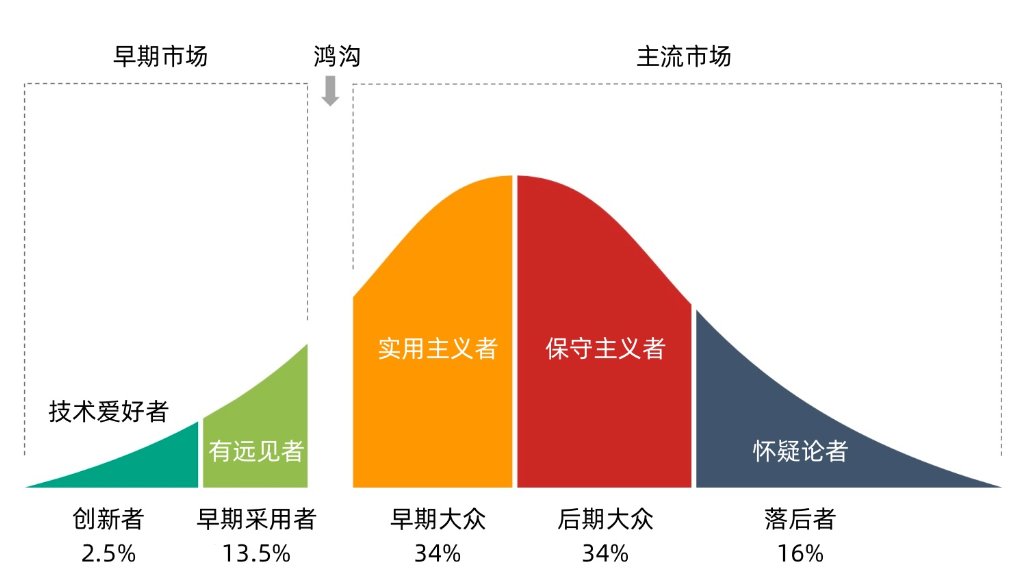
As shown in the above figure, the technology adoption lifecycle has a bell-shaped curve, and the boundaries of each stage correspond to the drop points of standard deviation. The proportion of each stage is as follows: innovators 2.5%, early adopters 13.5%, early majority 34%, conservatives 34%, and laggards 16%.
Innovators who actively pursue new technologies sometimes play an important role in the product improvement process, while early adopters are often good at promoting products and are the most important target of enterprises. However, the use of these two types of people is not a complete mark of product popularity, as they have significant psychological and consumption preference differences from mainstream consumers.Early adopters of Volkswagen were utilitarians who needed to see a large number of mature use cases; late adopters would wait until the new things became conventions before they felt comfortable using them; and the last 16% were skeptics, who would only use a product when the technology was deemed likely to exist long-term.
By 2022, the penetration rate of pure electric vehicles in China’s market has exceeded 20%, but the market is still in its early stages of development. Specifically, the consumer groups of new energy vehicles still maintain the characteristics of innovators and early adopters, and their purchasing reasons are more due to their preference for new products, new technologies, and new services. So, what is the most important factor in winning the “utilitarian”?
JL Insights has a very intuitive answer to this question: “range”, “charging time” and “charging convenience” are the main factors affecting new energy vehicle owners.
In the early days of electric vehicle development, the contradiction of insufficient endurance mileage was very prominent and became the first problem to be solved, which was also the guiding direction of government subsidies. By 2022, the average nominal range of newly launched models has exceeded 500km and the highest has exceeded 1000km, which can basically meet the long and short distance travel needs of consumers except in winter.
Therefore, the improvement of endurance mileage has led to the increase of long-distance travel scenarios for electric vehicles, which has amplified the travel demands between different cities, highlighting the insufficient replenishment plans. For electric vehicle owners, anxiety about replenishment has replaced anxiety about mileage as the main contradiction. Therefore, guided by policies, pioneers such as NIO have accelerated the promotion of supplementary charging methods such as fast charging and battery swapping.
In 2020, the country included the construction of charging station infrastructure into the “new infrastructure” field. The number of charging stations has increased rapidly, from 1.22 million in 2019 to 2.62 million at the end of 2021, and the ratio of cars to charging stations has decreased from 7.8:1 in 2015 to 3:1 in 2021. Another set of data shows that from Q1 2020 to Q3 2022, the number of public DC (fast charging) charging stations in China increased from 222,000 to 704,000, while the number of new energy vehicles increased nearly three-fold. By Q3 2022, the ratio of public fast charging cars to charging stations is 16:1.However, factors such as insufficient marketization and imperfect operation have resulted in a poor charging experience for electric vehicle owners in actual use, and many early slow-charging piles have actually been abandoned.
Qin Lihong introduced an interesting phenomenon that he had never thought of before – during the Spring Festival, the NIO charging pile with the highest number of cycles was located in Guiyang. This phenomenon at least illustrates two points: first, the high-frequency demand in lower-tier cities, and second, the current situation in which enterprises are not sinking enough.
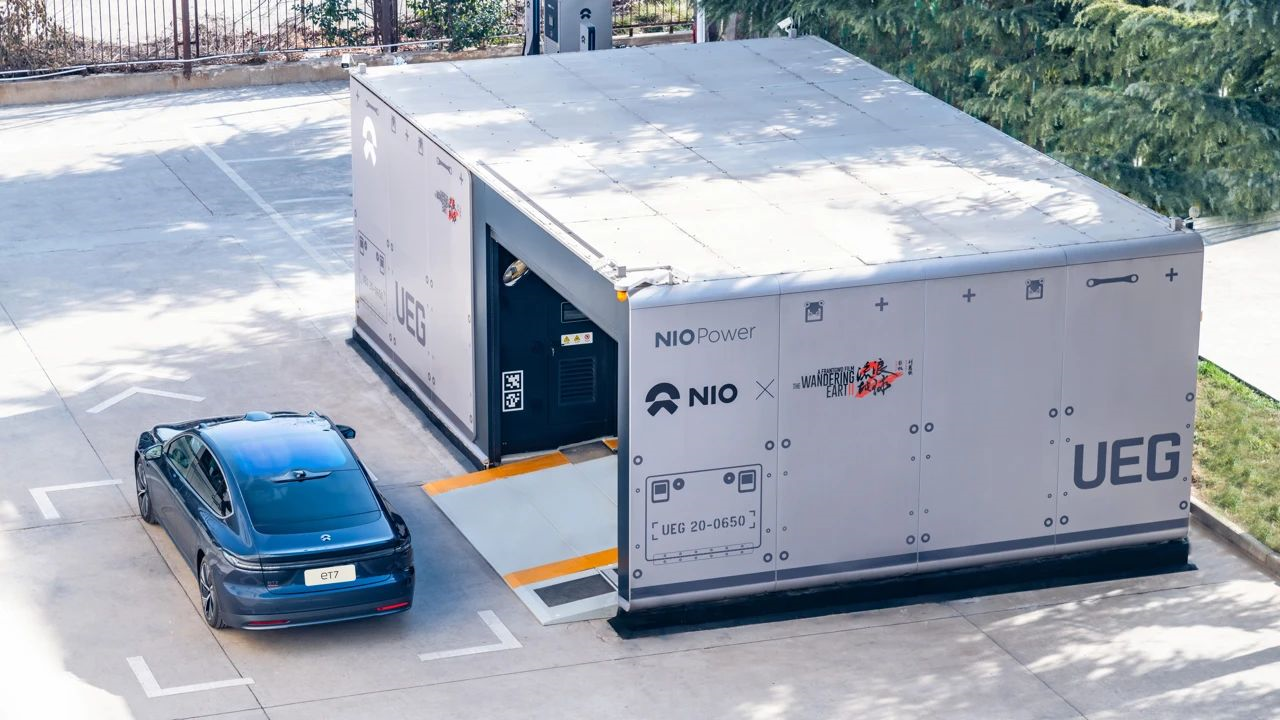
Fuel vehicles can be considered as having unlimited endurance because they can complete refueling in 5 minutes, while the energy supply efficiency of new energy vehicles is far from satisfactory in comparison.
According to consumer survey and measurement conducted by Orient Securities, a good electric vehicle usage experience requires refueling 300km in about 10 minutes. The test results of existing models on the market significantly deviate from this data, with most models unable to add more than 100km within 10 minutes, and some models unable to add even 50km under extremely cold winter conditions.
All the above explanations aim to illustrate the importance of optimizing the energy replenishment in order to achieve the market breakthrough of new energy vehicles. To this day, it remains a key factor that constrains the development of the industry.
For enterprises, seizing the opportunity of optimizing energy replenishment is the most critical competitive advantage. Whoever lays out the best will reap the most. From this perspective, NIO’s unique all-round energy replenishment service solution really does build a moat.
Take January 27th, the day with the highest traffic flow during the Spring Festival, as an example. The peak value of the daily toll station switch volume was reached, and the average waiting time for the switch station was 13.08 minutes. If the reservation starts within 100 meters of the switch station, the waiting time will be shortened accordingly, which is almost the same experience as traditional refueling. Compared with the embarrassment of other electric vehicle owners lining up to charge, NIO owners’ experience is obviously much stronger.
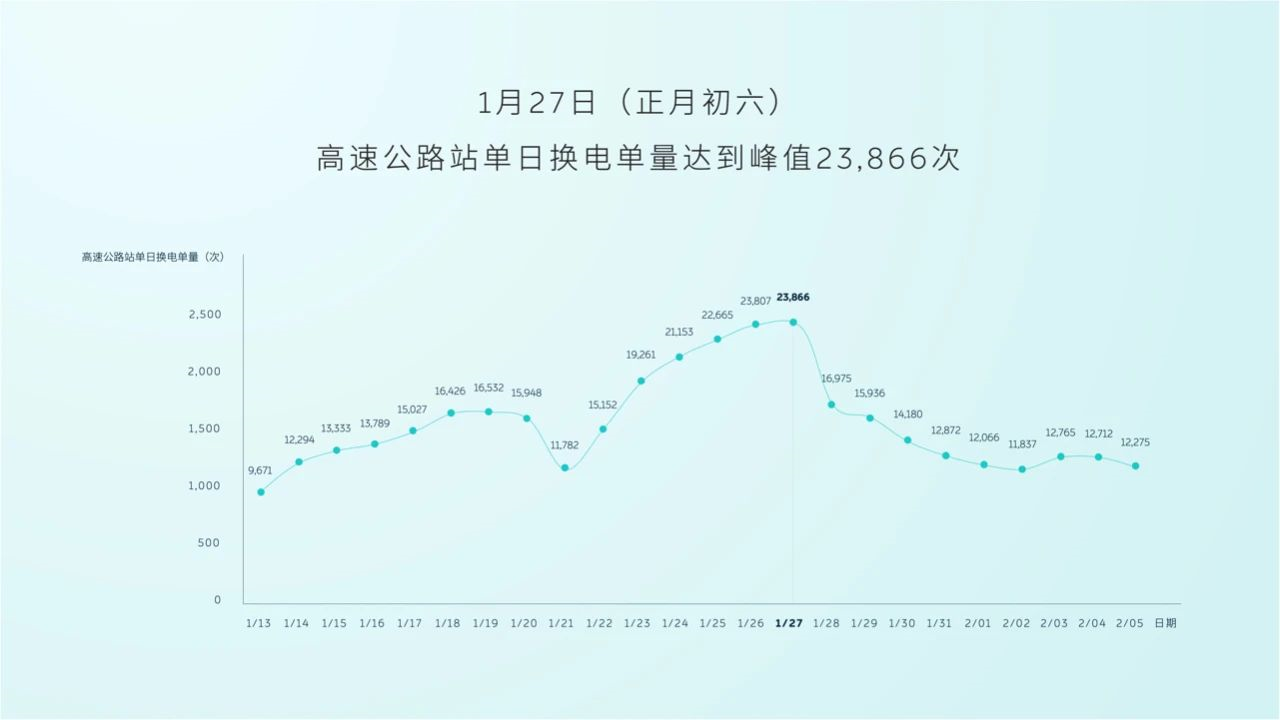
For the NIO brand, this is actually a very good marketing strategy, and the perfect performance allows other brand car owners to intuitively see the convenience of NIO’s energy replenishment, which is more convincing than any other way. It not only eliminates the anxiety of electric vehicle users, but also encourages more consumers to choose electric vehicles and choose NIO.In NIO’s 2025 battery swapping network plan, over 4,000 swapping stations will be built worldwide, with a coverage rate of 90% for NIO Homes (residences within 3 kilometers of a swapping station), and universal coverage for the high-speed battery swapping network in “9 horizontal, 9 vertical, and 19 metropolitan areas.” Additionally, 168 Power Up Plan charging routes will be established globally.
According to AutocarMax, as the number of NIO’s battery swapping facilities continues to grow, and with denser coverage in local areas and expansion to more remote regions, reaching a critical mass will enable charging to be as convenient as refueling, making it effortless for users to recharge wherever they go.
By solving this key pain point, NIO’s service infrastructure will work in tandem for greater synergy with its vehicle lineup and user community, among other things. More importantly, this synergy will catalyze a qualitative change in NIO’s development, leading the company into a path of high-quality development.
We believe that NIO’s transformation will also have a positive impact on the new energy vehicle market, providing even greater impetus for the industry’s development.
In this virtuous cycle, NIO, with better battery swapping services and a more robust infrastructure, will inevitably become the preferred option for pragmatic consumers.
This article is a translation by ChatGPT of a Chinese report from 42HOW. If you have any questions about it, please email bd@42how.com.
